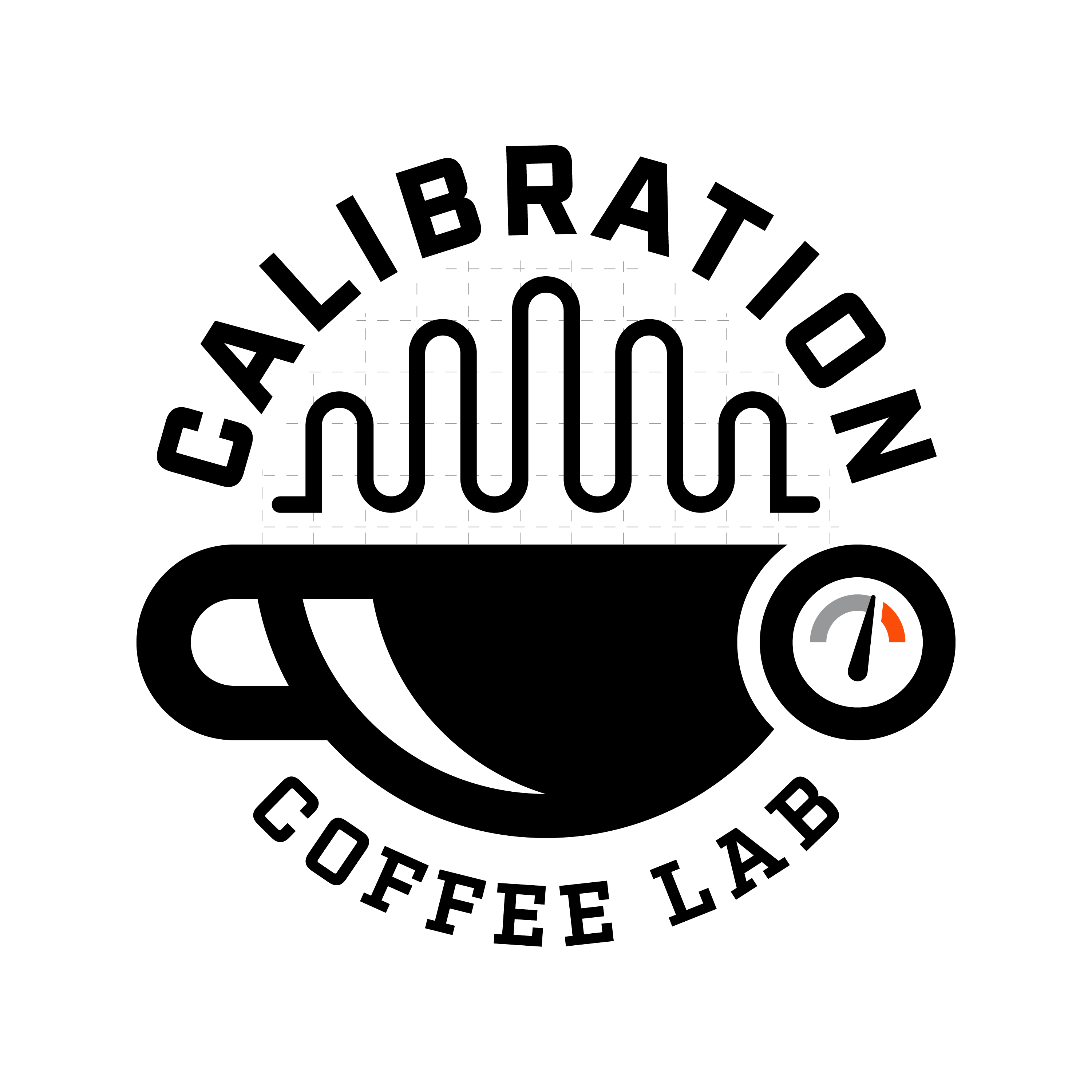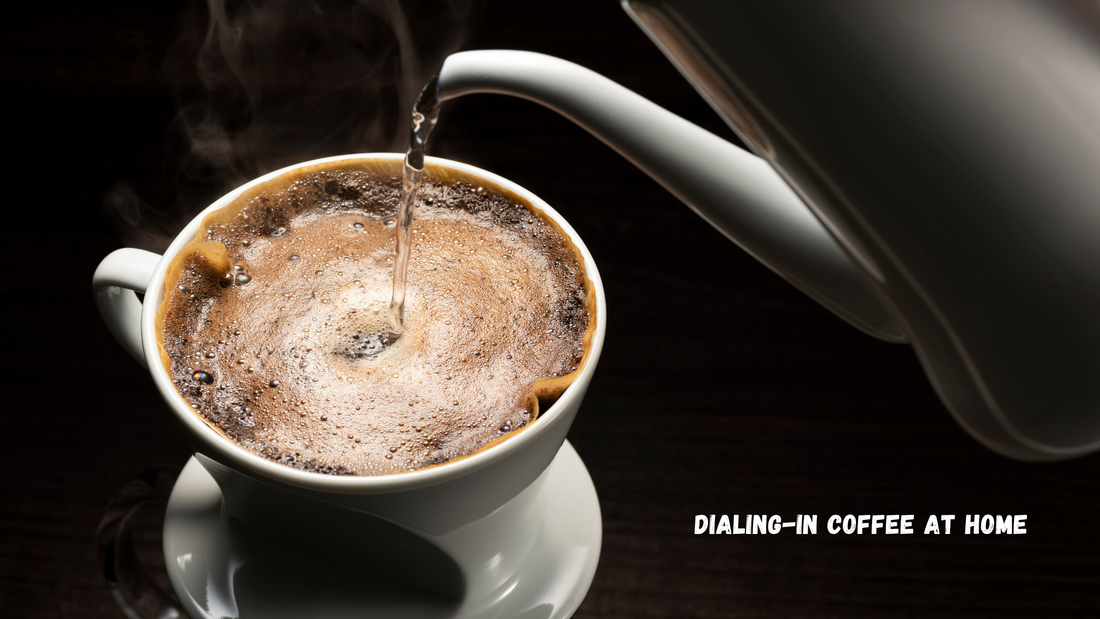Have you experienced mixed results when brewing a pot or a cup of coffee?
Let's talk about ways to improve our brewing experience with a focus on filter coffee. This would apply to most brewing methods that involve a filter like a coffee maker, a pour-over, an aeropress, etc. Most methods apply except for things like espresso or Moka pots. More to come on those methods in future posts. You can skip to the bottom for a summary.
At Calibration Coffee Lab, I design my roasts ultimately based on taste and what I expect to get out of that coffee. I choose to buy certain green coffee beans based on something I tasted at the cupping table. It could be certain fruit or floral notes or may its potential for a muted acidity and chocolatey feel.
Cupping is a method of brewing where we pour hot water over medium-fine coffee grounds in a small bowl and let the coffee steep for a couple of minutes before sipping with a spoon. This method gives a clear picture of what flavors we can expect from the coffee(and some impression of body) but may not translate to how the coffee presents in certain brewing methods.
The basics of brewing involve pouring hot water over ground coffee. We are trying to extract the flavor and texture components(oils, solids, and gases) from the coffee. Certain brew methods will allow different components to get into the cup. For example, a paper filter may trap many of the insoluble oils and solids from the beans whereas a French press won't. This is why French press coffee has a much different body than coffee brewed with a paper filter. A metal filter may also allow more insoluable components to enter the brewed coffee.
Here are the top items to consider when "dialing-in" coffee:
Grind Size for Coffee
I will do a separate post on grinding coffee because it is so important and is why there is a whole industry built around designing the latest and greatest coffee grinder. This is absolutely the biggest modulator of flavor in brewing coffee after roasting.
You can imagine that if we are trying to extract physical components from a coffee bean, that changing the surface area will have a great effect. A fine grind will allow water to more easily extract the coffee, but will also increase the resistance and slow down the brew. Think about pouring water over sand vs over pebbles.
A coarser grind will cause a faster brew and may not pull out the desirable flavor compounds from the coffee, but if the coffee is soaking in the water for a longer period of time, then a coarser grind may be preferable, as is the case with French press coffee or cold brew coffee.
We have to find the ideal grind size for a particular coffee and a particular brewing method, and we can only do that by tasting. There are methods to calculate extraction, but we will save that for another day. In the end, what matters is taste.
Here is a general rule of thumb:
- If the coffee is too bitter (think astringent, fruit pith, tannic, maybe muddy), grind the coffee coarser.
- If the coffee is too acidic (think sour, bright, thin), grind the coffee finer
Generally, you can mark your grinder for a particular brew method and use that setting most of the time. I have a mark for my coffee pot and one for pour-overs. This will work with most coffees. I find that with some coffees, like the current lot of our Guatemala Quetzal coffee, that I prefer a finer grind for the coffee pot to bring out more of the chocolate notes in the coffee and mute some of the fruit notes.
General Grinding Guidance:
- French Press: Coarse to Extra Coarse
- Coffee Pot/Maker and Cold Brew: Medium Coarse to Medium
- Pour-Over: Medium Fine
- Aeropress: Fine to Extra Fine
How much coffee do I use?
Obviously how much coffee we put in the brewer will affect how the coffee extracts and ultimately the flavor. There are many ways to approach this. Common guidance is 2 TBSP ground coffee for 6 oz of water. This approach will get you close and probably works great for a method like French press.
A better approach is to start with a brew ratio (coffee to water) and then weigh your beans. We weigh coffee beans vs measuring volume due to the variations in bean size, density, and grind size.
A stronger coffee may offer a bigger body and potentially muted/muddled flavors if too strong, a weaker coffee may result in thinner body and potentially lack of flavor if too weak.
An inexpensive kitchen scale is all that you need. I typically weigh the beans prior to grinding. Note:Your grinder may not spit out the same weight. For a coffee pot that uses 72 grams, if you lose 2 grams to the grinder, then it will have a negligible impact on the cup quality. If you grind 20g for a pour-over and the grinder spits out 18g, then you may want to add more coffee or adjust how much water you are using as it could impact the quality.
To determine how much coffee you need, you first need to weigh your water. You probably only need to do this once and then just use the same amount each time or use a linear correlation for a different amount of water. For example, I typically use a 1:17 ratio for an 8 "cup" coffee pot, which requires 72 grams of coffee. I also feel like this is about the max amount of coffee grinds my coffee pot can handle before over flowing.
For a pour-over I use 20g of coffee and stop pouring when I hit 300g, which is a 1:15 ratio.
My recommended starting doses:
- 1:16 to 1:18 for a coffee maker. I typically use 1:17
- 1:15 for a pour-over
- 1:14 for Cold brew
- 1:13.75 for Aeropress
Blooming Coffee
For manual methods like pour-overs, French press, and Aeropress, it is usually helpful to "Bloom" your coffee for the first 30 sec of the brew.
Have you ever brewed a pot of super fresh coffee and seen how much the coffee grounds rises at the beginning of the brew cycle?
This is because the coffee is swelling and bubbling as Carbon Dioxide is being released.
If you wet the grounds with a little hot water before starting the brewing, then this CO2 is released, and I bet that you could tell the difference if we placed two cups side by side, one bloomed, and the other not.
The CO2 being released will prevent proper extraction of soluble components from reaching the cup and if CO2 makes it into the cup, then it can result in a bitter flavor.
Some coffee pots offer a bloom feature, and you could also manually do it with a maker, but you would need to account for the water used in the bloom.
All you have to do is wet the grounds with your hot brew water and let it sit for 30 to 60 sec before continuing the brew.
Coffee Water and Temperature
Most people, including myself will not chase changing the water chemistry. Just know that it does affect flavor. We have great water in Greenville, SC and it isn't something I feel needs modifying, but the coffee will taste different with different water sources. I'll do a separate blog post on water modifications later.
Temperature is another variable that you do not often have control over in a coffee maker but will have it with manual brewing methods.
My general rule for temperature:
- Use water right off the boil for an open pour-over like a V60 because you lose a lot of heat in the process.
- For a French press or Aeropress, I will heat the water to 195-205degF.
- For Cold Brew I use room temperature water for 24hr before removing the coffee and chilling
How to brew the perfect cup of coffee:
Summary:
See some specific brewing guidance HERE.
Grind Size:
- Adjustments:
- If the coffee is too bitter(think astringent, fruit pith, tannic, maybe muddy), grind the coffee coarser.
- If the coffee is too acidic(think sour, bright, thin), grind the coffee finer
- French Press: Coarse to Extra Coarse
- Coffee Pot/Maker and Cold Brew: Medium Coarse to Medium
- Pour-Over: Medium Fine
- Aeropress: Fine to Extra Fine
Coffee Dose:
- Weight your coffee prior to grinding
- 1:16 to 1:18 for a coffee maker. I typically use 1:17
- 1:15 for a pour-over
- 1:14 for Cold brew
- 1:13.75 for Aeropress
Bloom:
- Bloom your coffee prior to brewing when you can. Thoroughly wet the grounds and let the coffee de-gas for ~30 sec. For a pour-over, I bloom with about 30-40g of water for 30sec.
Temperature:
- Use water right off the boil for an open pour-over like a V60 because you lose a lot of heat in the process.
- For a French press or Aeropress, I will heat the water to 195-205degF.
- For Cold Brew I use room temperature water for 24hr before removing the coffee and chilling
And of course, always try and use fresh, high-quality beans.
Thanks for reading!
Alex, Owner/Roaster of Calibration Coffee Lab

